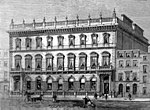St James's Square

St James's Square is the only square in the St James's district of the City of Westminster and is a garden square. It has predominantly Georgian and Neo-Georgian architecture. For its first two hundred or so years it was one of the three or four most fashionable residential streets in London. It now has headquarters of a number of well-known businesses, including BP and Rio Tinto Group; four private members' clubs, the East India Club, the Naval and Military Club, the Canning Club, and the Army and Navy Club; the High Commission of Cyprus; the London Library; and global think tank and peace-promoter Chatham House. A main feature is a high, stone-plinthed equestrian statue of William III erected in 1808.
Excerpt from the Wikipedia article St James's Square (License: CC BY-SA 3.0, Authors, Images).St James's Square
St James's Square, City of Westminster Victoria
Geographical coordinates (GPS) Address Nearby Places Show on map
Geographical coordinates (GPS)
| Latitude | Longitude |
|---|---|
| N 51.507244 ° | E -0.135299 ° |
Address
William III
St James's Square
SW1Y 4JH City of Westminster, Victoria
England, United Kingdom
Open on Google Maps







